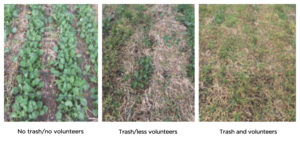Ploughing still the preferred option for Scottish soils12 September 2017
Minimum tillage may save time. But ploughing could be a better option on many Scottish soils, especially before planting winter oilseed rape.
That is the message from Alistair Gordon, regional technical manager in Scotland for agronomy firm ProCam, who says the benefits of ploughing can be felt from establishment right through to harvest.
“Ploughing gives fewer crop failures and a more consistent yield,” explains Mr Gordon, “and reduces slug numbers and volunteer cereals in oilseed rape. Our biggest challenge with oilseed rape is simply getting the crop up and away.
“Ploughing also opens up the soil so it is freer-draining, and helps eliminate problems with sterile brome, which are increasing.”
Even when growing hybrid oilseed rape varieties which offer enhanced autumn vigour, Mr Gordon says it is still essential to create the best soil conditions for establishment.
Financially, he says once the cost of extra inputs that may be needed after using minimum tillage are considered, the cost benefit over ploughing can be lost.
“Where you min till, you have to control slugs and control volunteer cereals in oilseed rape. Once you add in the cost of applying slug pellets and taking out volunteers, establishment costs for either method look remarkably similar.
“I can understand why people use min till on heavier soils in England – because if you plough heavy clay it can take a lot of power harrowing afterwards to get anything approaching a nice seedbed.
“But ours are mainly sandy soils, and we can almost go straight in after the plough with a drill. Also, min till doesn’t work as well up here where soil conditions are wet. And trying to put a subsoiler through the soil in a catchy, wet season just creates slots, leading to problems with slugs.”
That said, min till is practical in drier conditions and where there aren’t sterile brome problems and not so much crop residue, says Mr Gordon, as well as on some heavier soils, for example around Aberdeenshire.
In other situations, he urges growers to plan crop rotations well in advance, to allow enough space to incorporate ploughing into the programme.
“People often use min till to save time, because they are trying to get winter oilseed rape in after spring barley by the first week of September.
“That’s understandable, but ideally you want to be planning which fields are going into oilseed rape 12 months ahead. That way, you can prioritise those as the first fields to drill with spring barley, so you know they’ll be harvested first and give you maximum time to plough.
“If you can’t plough the whole field, at least consider ploughing an 8-metre band all around the headland. This area needs loosening the most because it suffers more compaction with machinery turning.
“A key decision to take before ploughing, which has an impact on crop establishment, is whether to incorporate or bale the cereal straw. People like the extra income from baled straw. Also, if you bale it, the cultivation machinery doesn’t have to cope with trash, and less trash helps to reduce slugs.
“My preferred option would be plough every year and before every crop, and remove the straw if the weather allows.
“If slugs are a problem, they mostly come from the field boundary, but new metaldehyde stewardship scheme rules require a 10-metre exclusion boundary around the whole field. So, if slug pellets are needed, I’ll be using Ironmax Pro slug pellets, which is a ferric phosphate product,” he adds.
Effects of trash and volunteers on OSR establishment
As well as ploughing, removal of trash and volunteer cereals can have big benefits for oilseed rape establishment, says Alistair Gordon, regional technical manager in Scotland for agronomy firm, ProCam

